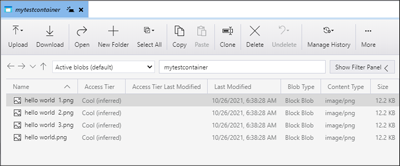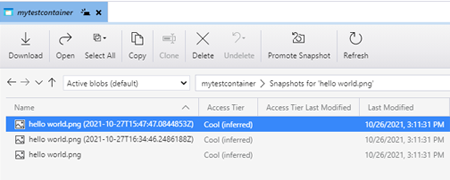

- #VIEW BLOBS IN AZURE STORAGE EMULATOR HOW TO#
- #VIEW BLOBS IN AZURE STORAGE EMULATOR UPDATE#
- #VIEW BLOBS IN AZURE STORAGE EMULATOR DOWNLOAD#
I am running azure storage emulator from a docker container.
#VIEW BLOBS IN AZURE STORAGE EMULATOR UPDATE#
Was working last week before I did a windows update and storage explorer update. Solution: you can go to user folder in following address and delete existing AzureStorageEmulatorDb510.mdf and ldf files.(last suffix 510 stands for version 5.10 of emulator) C:\Users\ Trying to connect to blob storage in Azure Storage Emulator. Running "AzureStorageEmulator.exe clear all" & "init" command usually hangs (or may take too much time) Visual Studio 2019 and deprecated Azure Storage Emulator it seems that Azurite has to explicit stop and clear command at the moment (3.14.3) and if you cannot delete this folder just close both Visual Studio and Storage Explorer and try again.Azure Storage Explorer Will automatically connect to this new emulator VIA REST-API and if you using Legacy Emulator and new emulator at the same time you are working with different data sets and New Azure do not use SQL server.you will see Azurite services starting up in Visual Studio Service Dependencies Window when you open VS with any project that needs this.I have observed this not only using Storage Emulator, but even the actual Azure Storage.
#VIEW BLOBS IN AZURE STORAGE EMULATOR DOWNLOAD#
You can download the Linux version here.It will not use SQL Local Server and all the related data is stored as a large JSON file in the following folder I got the URL of the container by clicking Copy URL in the Storage Explorer toolbar, removing the path to the blob and adding the query string. This emulator is for Windows, but if you need to run on Linux, there is a version named Azurite. If you hover over it, it should say 'Compute Emulator is ' (may be started or shutdown) and 'Storage Emulator is started'. It looks like the Windows logo, but all blue. Finally, we created some queues and tables in the Azure emulator and checked where they are stored. If so, you shouold see the Windows Azure logo in the 'System Tray' - the area next to the clock in your task bar.

#VIEW BLOBS IN AZURE STORAGE EMULATOR HOW TO#
We also reviewed how to create Azure Containers, upload and download files using the emulator. Stores all the information in SQL Server tables using the SQL Server LocalDB.Īlso, we learned how to use the Works on the command line and you can start or stop it using commands.Īllows saving the money that Azure may charge if we load data in the Azure Storage Account to test. In this article, we learned that we can simulate the Azure Storage Account behavior using the emulator which: Note: It is also possible to run the emulator in Docker. The limit supported for the blob size is 2 GB. It is a simple SQL Server LocalDB instance, and therefore it does not support a heavy workload and it is not designed to have good performance. It should not be used in production because: We use the resulting StorageCredential to initialize a CloudStorageClient object, explicitly providing the storage emulator endpoint for blob storage. The Azure local storage is used for development purpose only. In step 6, we create a StorageCredentialsAccountAndKey instance from the explicitly provided storage emulator values for account name and access key.

The following query will show the table created: It is a name-value pair associated with the container or blob. We can store some amount of information against a container or blob as metadata. The reserved URL characters must be escaped properly.

The Storage Emulator now supports version 2017. Yes (v3.7) Yes (v3.7) Storage Explorer: Allows you to locally view Azure Storage accounts and contents, including Azurite. The Storage Emulator now supports version of the storage services on Blob, Queue, and Table service endpoints. It starts a local server that behaves like Azure Storage, so you can dev against it like you would Azure. You can press Add to create a new table and add new properties to the table. The Azure Storage emulator supports blob names up-to 256 characters long. Azurite is an open source Azure Storage emulator that supports Windows and Linux. In MASE, go to tables and create a new table: The dbo.QueueMessage contains the messages created in the queues. You will be able to see the queue1 just created:


 0 kommentar(er)
0 kommentar(er)
